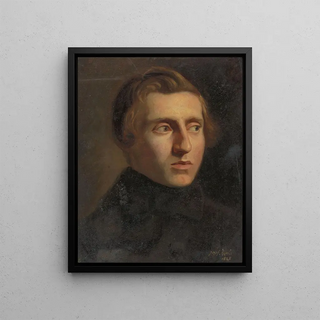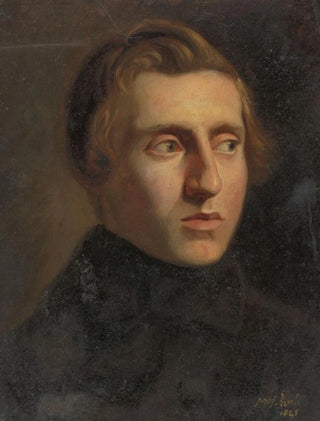Art print | Portrait of a Young Man - Jozef Israëls


View from behind

Frame (optional)
Jozef Israëls's "Art print of a young man" is a work that transcends the simple act of painting to become a true exploration of the human soul. In this depiction, the artist manages to capture a delicate essence, fragility, and depth that invite contemplation. By focusing on the young man's gaze, one feels an intimate connection, as if witnessing a moment suspended in time. Every brushstroke seems charged with emotion, and the atmosphere emanating from the canvas transports the viewer into a universe where beauty and melancholy coexist.
Style and uniqueness of the work
The uniqueness of this piece lies in the mastery of light and shadow, which gives the figure of the young man an almost sculptural dimension. Israëls, a true virtuoso, plays with nuances to reveal the contours of the face and the subtleties of expression. The colors, both soft and vibrant, intertwine harmoniously, creating a visual balance that immediately captures attention. This portrait is not limited to a simple physical representation; it evokes a rich inner world, where every look, every smile, tells a story. The chiaroscuro technique, so dear to master painters, is used here with remarkable finesse, thus enhancing the emotional intensity of the work.
The artist and his influence
Jozef Israëls, an emblematic figure of the Hague School, established himself as one of the great masters of Dutch painting in the 19th century. His artistic journey is marked by an incessant quest for truth and authenticity. Influenced by the great masters of the past, he develops a style that is uniquely his own, combining realism and romanticism. Israëls is particularly interested in everyday life, figures of the people, and the human condition, which allows him to create works imbued with profound humanity. His impact on his contemporaries and future generations is undeniable, and his innovative approach continues to inspire many artists. The "Art print of a young man" perfectly illustrates this ability to combine technique and emotion.

Matte finish

View from behind

Frame (optional)
Jozef Israëls's "Art print of a young man" is a work that transcends the simple act of painting to become a true exploration of the human soul. In this depiction, the artist manages to capture a delicate essence, fragility, and depth that invite contemplation. By focusing on the young man's gaze, one feels an intimate connection, as if witnessing a moment suspended in time. Every brushstroke seems charged with emotion, and the atmosphere emanating from the canvas transports the viewer into a universe where beauty and melancholy coexist.
Style and uniqueness of the work
The uniqueness of this piece lies in the mastery of light and shadow, which gives the figure of the young man an almost sculptural dimension. Israëls, a true virtuoso, plays with nuances to reveal the contours of the face and the subtleties of expression. The colors, both soft and vibrant, intertwine harmoniously, creating a visual balance that immediately captures attention. This portrait is not limited to a simple physical representation; it evokes a rich inner world, where every look, every smile, tells a story. The chiaroscuro technique, so dear to master painters, is used here with remarkable finesse, thus enhancing the emotional intensity of the work.
The artist and his influence
Jozef Israëls, an emblematic figure of the Hague School, established himself as one of the great masters of Dutch painting in the 19th century. His artistic journey is marked by an incessant quest for truth and authenticity. Influenced by the great masters of the past, he develops a style that is uniquely his own, combining realism and romanticism. Israëls is particularly interested in everyday life, figures of the people, and the human condition, which allows him to create works imbued with profound humanity. His impact on his contemporaries and future generations is undeniable, and his innovative approach continues to inspire many artists. The "Art print of a young man" perfectly illustrates this ability to combine technique and emotion.






